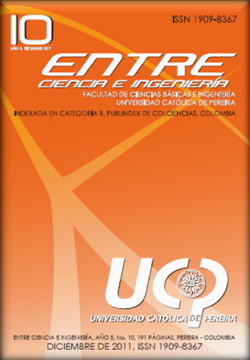Prediction for a Mathematical Model in the Residence Times Distribution for an Electrochemical Reactor Type Press Filter
Keywords:
residence time, mathematical mode, electrochemical reactorAbstract
In the research referred in the present article, the author presents thestudy of a filter press type electrochemical reactor at pilot scale, whichanalyzed the Residence Times Distribution (RTD), which is fundamental inits hydrodynamic behavior; to do so a tracer injection at the reactor inletwas used, measuring the change in conductivity at both the entranceand exit. Then, by mathematical analysis, the type of dispersion, stagnantareas and the main variables that affect the working fluid was determined.Once it was achieved, a mathematical model for the design and operationof the reactor was used. Now it is ready to be used at industrial levels, inevery aspect related to metal recovery and recycling, proposing a solutionfor all those environmental problems that people face nowadays.
References
Bazan, J. C., and Bisang, J. M.; (2004). Journal of Applied Electrochemistry. Pp. 501-506
Benkhelifa, H., Legrand, J., Legemtilhomme, P., Montillet. A.; (2000). Chemical Engineering Science. Pp. 1871-1882
Doherty, T., Sunderland, J. G., Roberts, E. P. L. and Pickett, D. J.; (1996). Electrochimica Acta. Pp. 519-526
Fylayson, B. A. (1980). “Nonlinear Analysis in Chemical Engineering”. McGraw- Hill; New York. Pp. 125-127
García-Gabaldón, M., Pérez-Herranz, V., García-Antón, J., Guiñón, J. L.; (2005). Separation and Purification Technology. Pp. 183-191
González-García, J., Montiel, V. and Aldaz, A.; (1998). Industrial Engineering Chemical Research. Pp. 4501-4511
González-García, J., Frias, A., Expósito, E., Montiel, V. and Aldaz, A.; (2000). Industrial Engineering Chemical Research. Pp. 1132-1142
Guddati, S. L., Holsen, T. M., Li, C. C., Selman, J. R., Mandich, N. V.; (1999). Journal of Applied Electrochemistry. Pp. 1129-1132
Hasson, D., Drak, A., Komlos, C., Yang, Q., Semiat, R. ; (2004). Desalination. Pp.132-144
Levenspiel, O. (2004). “Ingeniería de las Reacciones Químicas”. Tercera Edición. Limusa Wiley. México. Pp 225-281 • Martin, A. D. (2000). Chemical Engineering Science. Pp. 5907- 5917
Mandich, N. V. Li, C. C., and Selman, J. R.; (1997). Plating and Surface Finishing. Pp. 82-90
Masly, A. I., Poddubny, N. P., Medveded, A, Z., Zherebilov, A. F.; (2007). Journal of Electroanalytical Chemistry. Pp. 180-190
Pérez-Herranz, V., Guiñón, J. L., García-Antón, J.; (1997). “Ingeniería Electroquímica”. Universidad Politécnica de Valencia. SPUPV-97.897. Pp. 95-108
Reyes H. (2007). Tesis Doctoral. Universidad Politécnica de Valencia. Pp. 78-80
Reyes H. García M, Pérez V. Int. J. (2011). Electrochem. Sci. 1493 – 1507
Sánchez, E., Mestre, S., Pérez-Herranz, V., Reyes, H., Añó, E.; (2006). Desalination. Pp. 668-670
Smith, W. H. and Foreman, T.; (1997). Separation Science and Technology. Pp. 669-679
Tsamatsoulis. D. and Papayannakos, N.; (1994). Chemical Engineering Science. Pp. 523-529
Tyrtshinov, E. “A bried introduction to numerical analysis”. (1997). Ed. Birkhauser Boston. Pp. 312-316
Zhang, T., Wan, T., Wang, J.; (2005). Chemical Engineering and Processing. Pp. 1221- 1227








 Revista Entre Ciencia e Ingeniería
Revista Entre Ciencia e Ingeniería .png) entrecei@ucp.edu.co
entrecei@ucp.edu.co.png) ISSN (Impreso) 1909-8367 - ISSN (En Línea) 2539-4169
ISSN (Impreso) 1909-8367 - ISSN (En Línea) 2539-4169 Attribution-NonCommercial 4.0 International (CC By-NC 4.0)
Attribution-NonCommercial 4.0 International (CC By-NC 4.0)
.png) Carrera 21 No. 49-95 Av. de las Américas, Pereira, Risaralda, Colombia
Carrera 21 No. 49-95 Av. de las Américas, Pereira, Risaralda, Colombia